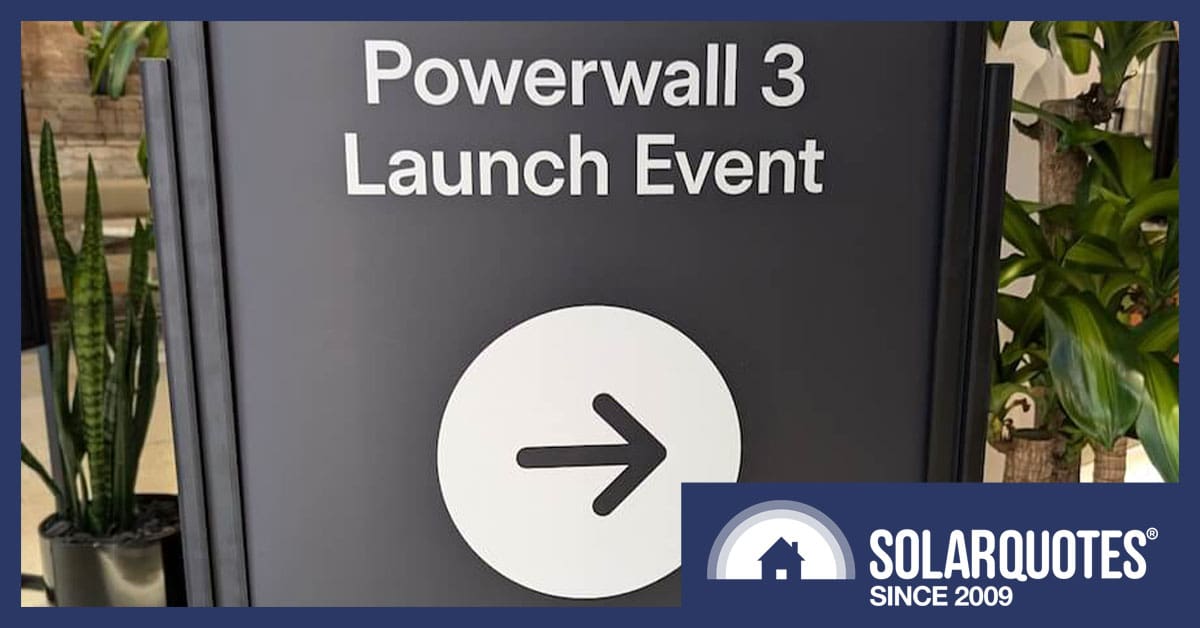
Tesla just held a detailed media and installer briefing about the new Tesla Powerwall 3 (PW3) in Sydney, and I was there for SolarQuotes to make sure I got answers to key technical questions no one else is likely to ask…
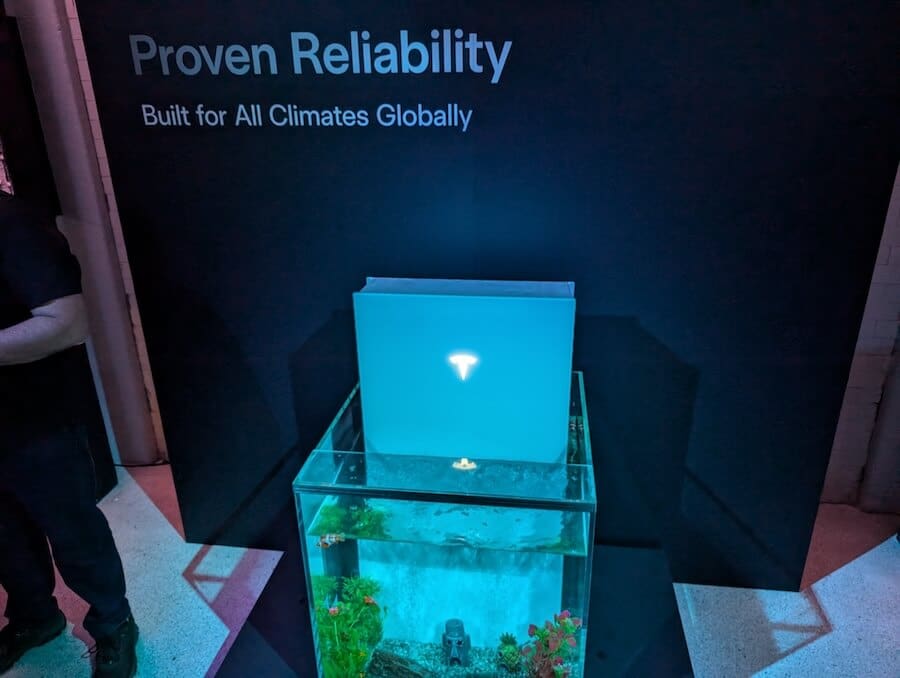
Tesla showing off the flood resistance of the Powerwall 3.
Look closely at the Australian version of Tesla’s Powerwall 3, and you’ll realise there have been significant improvements made from the Powerwall 2 including:
- switching to LFP cells (13.5kWh usable), with preheat mode (for max power on cold mornings)
- built-in solar inverter, which supports up to 20kW of DC solar per PW3
- built-in 3x high current MPPT tracker modules (unlike the USA, which gets 6 x lower current MPPTs)
- Up to 11.04 kW discharge rate (up from 5kw in PW2) supporting larger appliances like ducted AC and reducing clipping
- integrated DC isolator
- reportedly faster installation
- returnable reusable packaging
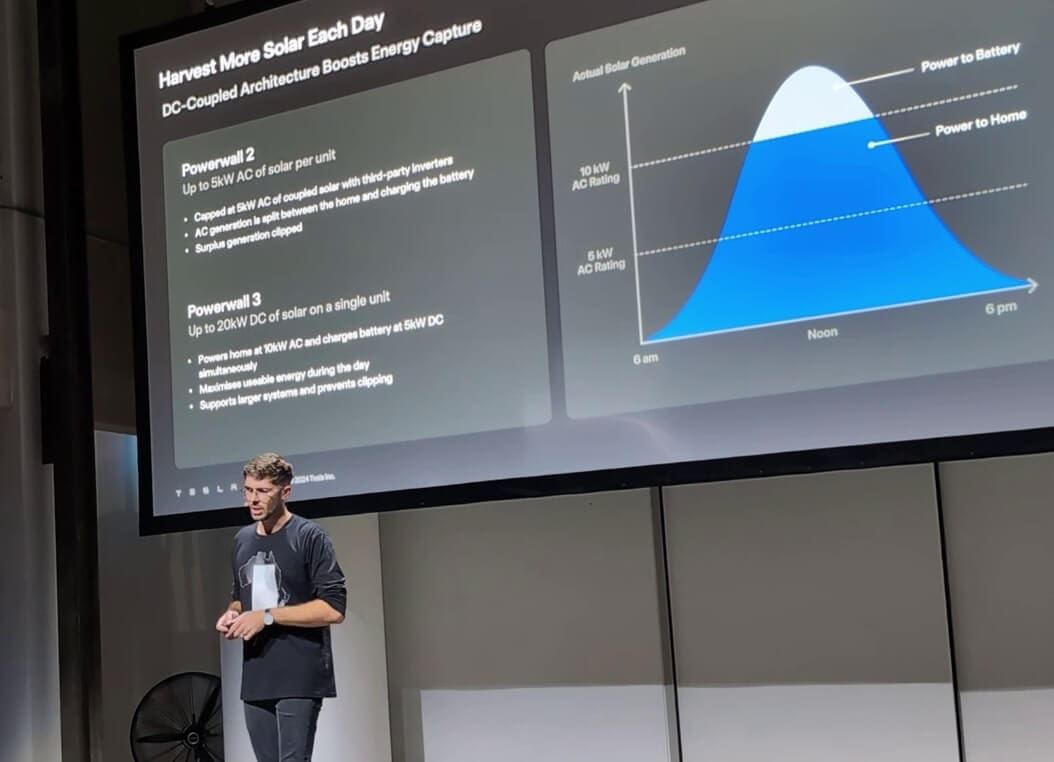
Comparing Powerwall 2 and Powerwall 3 specs at the Launch Event in Sydney
For brand new installs of solar-plus-batteries, this means you could skip buying a traditional solar inverter from Fronius, Sungrow, Goodwe, etc and connect up to 3 strings of solar directly to the Powerwall 3.
Tesla claims that the built-in solar inverter can handle complex roofs and shading with ease, with Solar to Home/Grid efficiency of 97.5% and Solar to Battery to Home/Grid Efficiency of 89%.
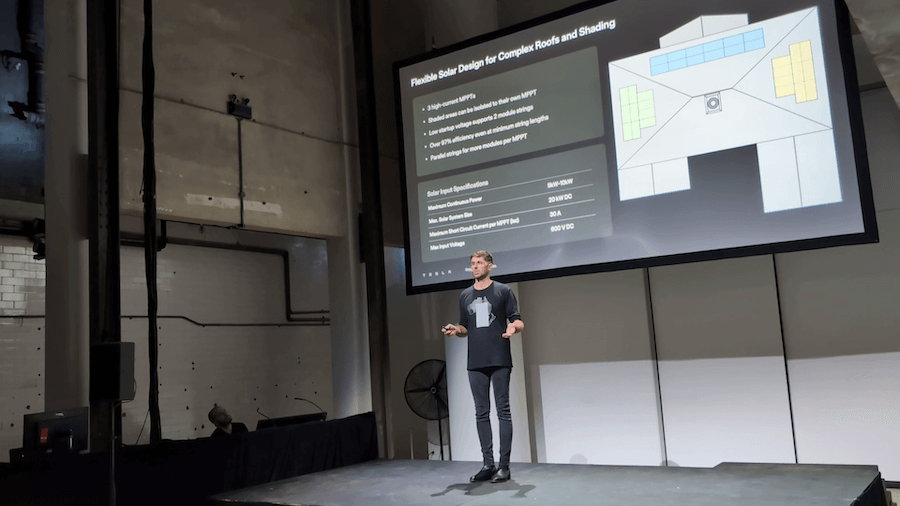
PW3’s three MPPTs let you easily put panels on three roof areas facing different directions.
If you were hoping that Tesla switching to LFP for the new Powerwall 3 would reduce the cost compared to the Powerwall 2, you may be disappointed. A Tesla spokesperson said that:
“making a cheap product that compromised on performance was not an option for us”.
Comparing the trio of PW1 vs PW2 and PW3 it’s clear that a lot has happened since Tesla Energy launched the first 6.4 kWh Powerwall 1 in 2015, followed quickly by the 13.5 kWh Powerwall 2 less than a year later.
For each new generation of Powerwall, Tesla has integrated more of the external “boxes”, thereby:
- reducing external wiring
- improving efficiency
- improving aesthetics
- reducing the parts cost for installers
- resulting in faster installations onsite.
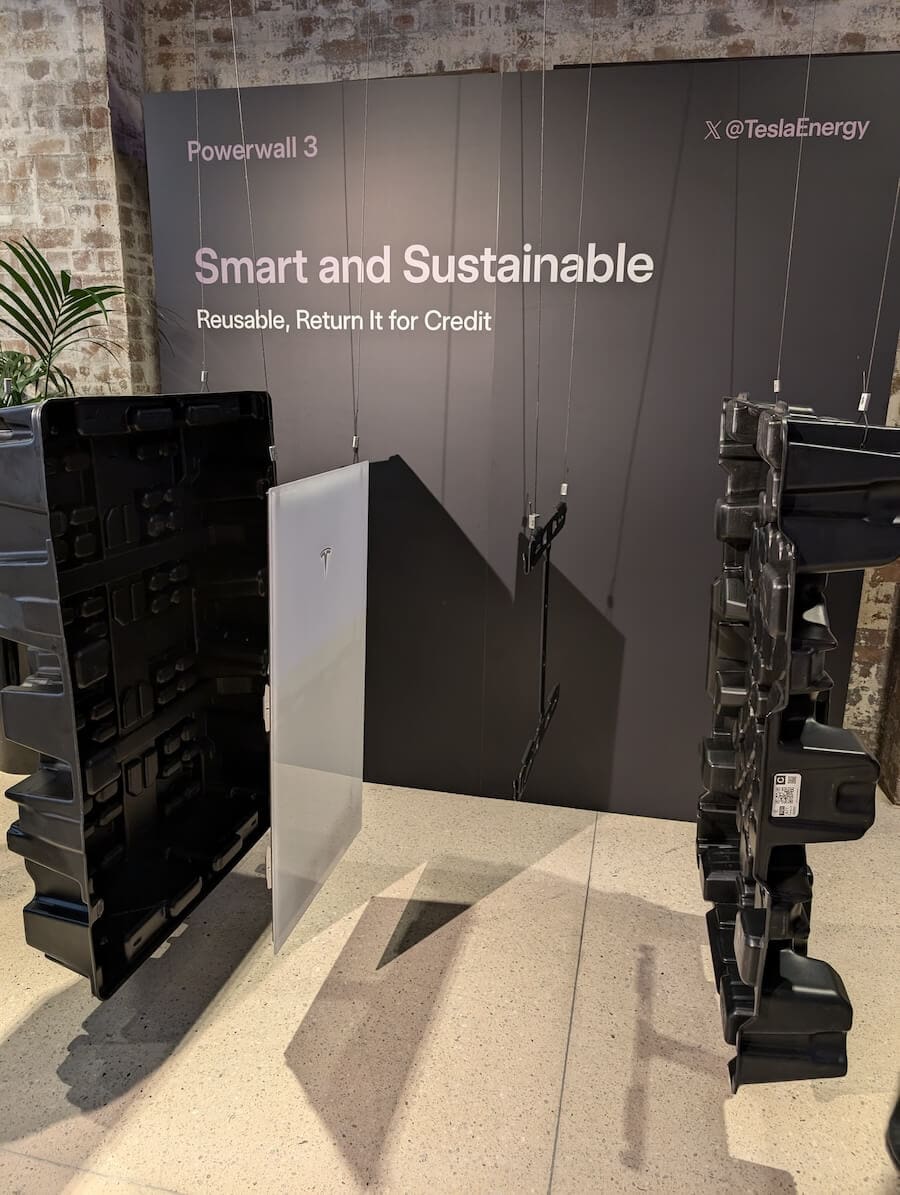
Reusable, returnable packaging, glass front plate and wall bracket.
Powerwall 3 Q & A
With regard to commonly asked technical queries from SolarQuotes readers, I ascertained the following at the media briefing:
How much does PW3 cost?
“Pricing for Powerwall 3 is $13,600 AUD and $15,600 NZD including Gateway 2 excluding installation. The price of Gateway 2 remains unchanged”.
What about PW3 Energy Expansions?
“Powerwall 3 Energy Expansions are currently scheduled for launch in early 2025. Pricing for these will be made available closer to launch. Powerwall 3 Energy Expansions will be more affordable than a Powerwall 3”.
Does PW3 come with stack kit for multiple installs?
“At launch, you will be able to install up to 4 Powerwall 3s in parallel to provide up to 40kWs of inverter capacity, 54kWh of storage, and up to 80kW of solar. Each Powerwall 3 will require its own mounting bracket”.
“Powerwall 3 Energy Expansion units will be available in 2025. They will be stackable behind each Powerwall 3 and installed with a single factory-supplied expansion cable. This expands systems to 4x Powerwall 3 units, each with up to an additional 3x Powerwall Expansion units, 16 in total.”
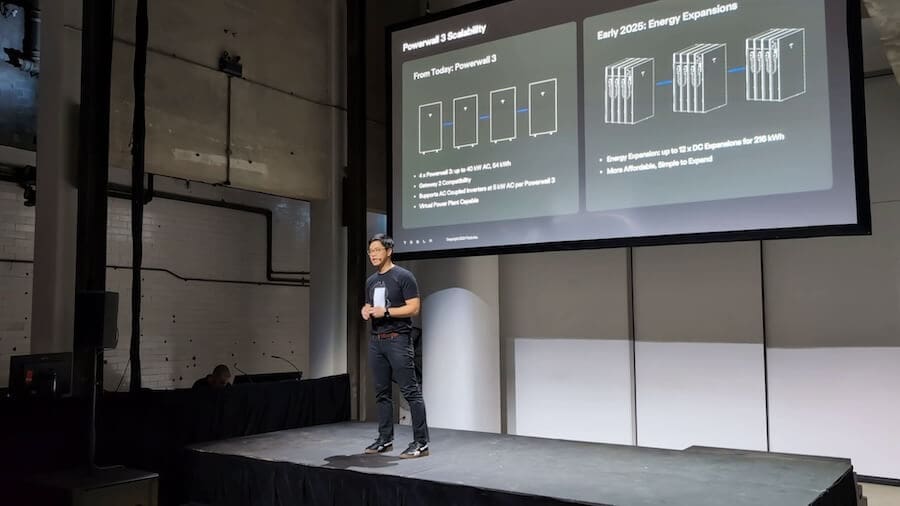
Explaining how PW3 is stackable with 3 other PW3s or 3 cheaper expansion units – coming in 2025
Are Tesla discontinuing the PW2? If you are – and a customer has a PW2 – can you expand your storage with a Powerwall 3 slave unit?
“Powerwall 3 will become Tesla’s home storage solution. Powerwall 2 owners are encouraged to speak with Certified Installers if they are looking to expand their current system using additional Powerwall 2 which will continue to be available for some time”.
Is PW3 compatible with PW2 and existing solar?
“Powerwall 3 is not currently compatible with Powerwall 2. For customers with existing solar systems, Powerwall 3 can be AC coupled and is compatible with all solar inverters”.
Will PW3 support bidirectional charging with a Wall Connector and a compatible car?
“Powerwall is a standalone home battery product that is bi-directional by design to both charge and discharge to the grid. Bi-directional vehicle charging is not available in Australia at this time”.
Do Tesla support PW3 for off grid?
“Powerwall 3 has a grid forming inverter and can provide backup protection for extended periods in grid tied applications. Off grid applications may be supported in the future”.
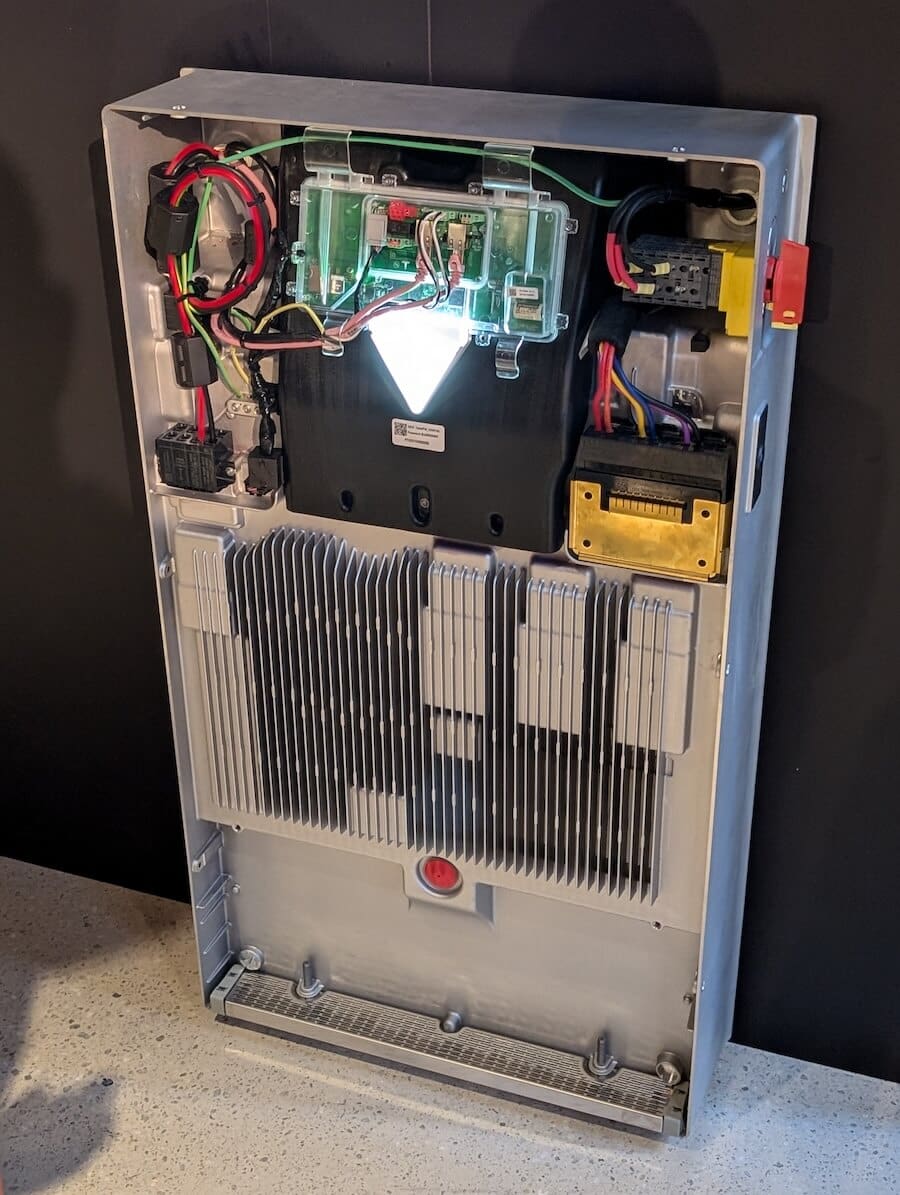
Inside the Powerwall 3 – it’s quite spacious actually. That will make installation easier.
Is PW3 limited to 9.99kW in Aus?
“No, Powerwall 3 is rated for 10kW”.
When is native 3 phase support available?
“PW3 can support loads on multiphase sites through net metering with backup on a single phase”.
DNSP inverter limits might cause problems unless they have 3 phase… so will the PW3 have a gateway arrangement like PW2 does?
“Yes. Powerwall 3 maintains compatibility with Gateway 2. Powerwall 3 is sold with Gateway 2”.
Will PW3 have an extended warranty if used with Tesla VPP?
“Powerwall 3 is fully VPP compatible, we haven’t announced yet any changes to Tesla Energy Plan or how Powerwall 3 will work with Tesla Energy Plan”.
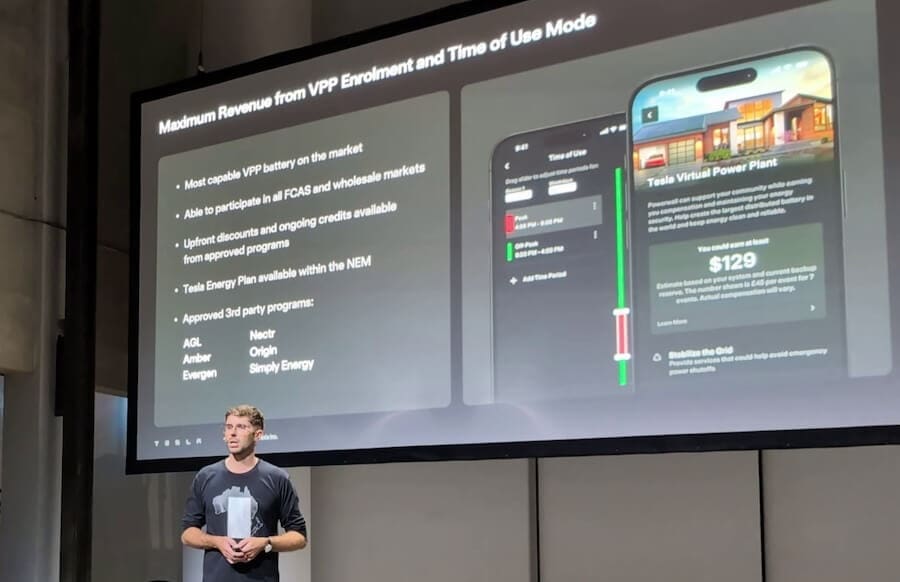
Powerwall 3 is compatible with The Tesla Energy Plan, Amber and VPPs from AGL, Origin, Evergen, Simpy Energy, and those people that dress up like bees.
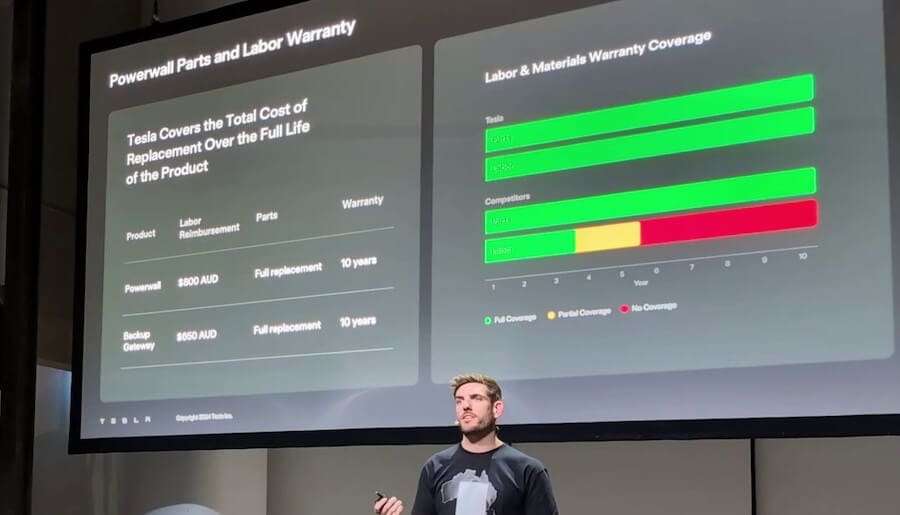
Tesla confirms that they are happy to pay labour costs during the 10-year warranty: $800 for replacing the PW3 and $650 for replacing the Gateway.
Can PW3 do a black start?
“Yes. Powerwall 3 has a grid-forming inverter and can provide backup protection for extended durations”.
“Powerwall 3 has enhanced black start capabilities with the ability to inject up to 185A to start large devices with motors such as heats pumps, pool pumps, air conditioners and electric vehicle charging”.
Will PW3 be legal in WA with their 5kW inverter limit?
“Yes, PW3 will be listed with the CEC and compliant to Australian Standards. Powerwall 3 will have a 5kW configurable variant through software at commissioning”.
How much quicker is to install PW3 compared to PW2?
“Our certified installers are telling us that they are going from 1 solar and Powerwall installation a day to 2 installations a day. We’ve made improvements to tooling and commissioning which reduces installation cost and time”.
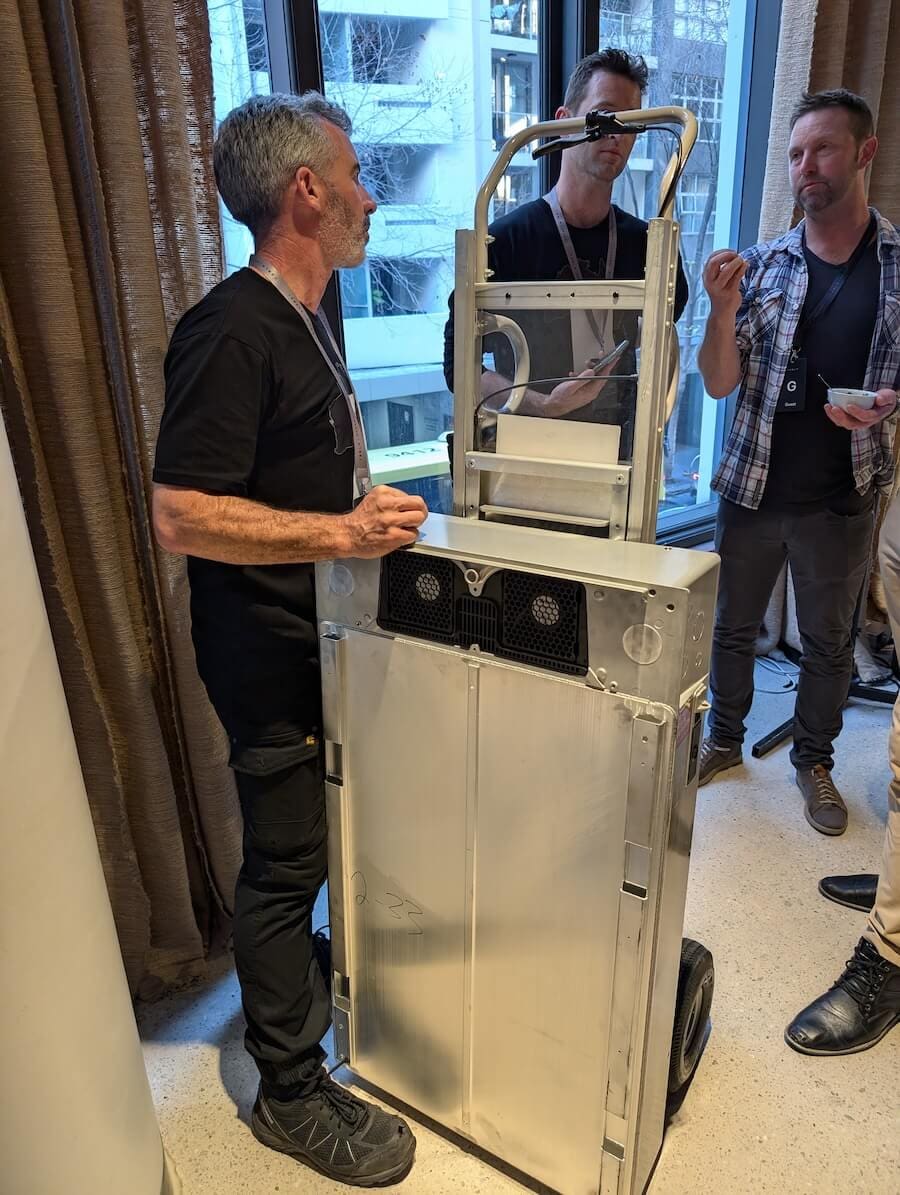
Tesla have designed a trolley that easily removes the Powerwall 3 from the packaging without risking the installer’s back.
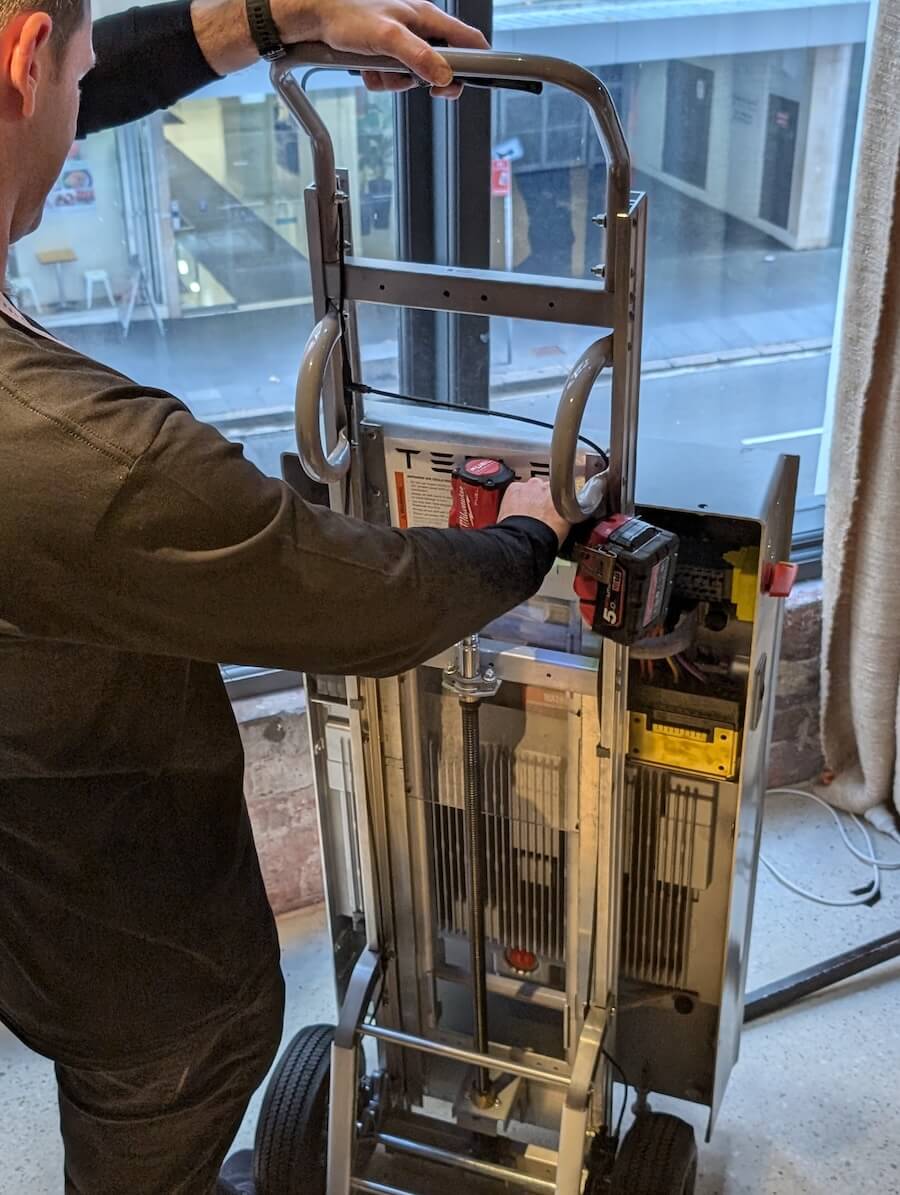
Installers can raise the 130kg Powerwall 3 with their drill. Tesla claims this makes 1-person installs feasible.
What happens next?
Pre-orders for the PW3 are available now either direct from Tesla, or – even better – via your favourite Tesla-certified installer.
Installer training begins on Monday, August 19th. The all-important CEC Listing is in the final stages and expected to be completed within a few weeks, after which deliveries are due in late September.
To compare the Powerwall 3 with other batteries on the Australian market, visit our constantly updated Battery Comparison Table.
Get Quotes For Powerwall 3 + Solar
The most cost-effective way to get a Powerwall 3 is to take advantage of the built-in solar inverter: with a big solar array.
To get multiple quotes for a Powerwall 3 and solar, you can use our ‘get quotes’ service:
First, choose your closest location,
- then click ‘more filters’
- Look for ‘Battery Brands Sold’
- check ‘Tesla’
- and choose the installers you’d like a quote from.
Or if that’s too much choice, just go here, and we’ll choose for you. Just be sure to write “Tesla Powerwall 3” when we ask for ‘any other info’.
So, are you likely to invest in a solar-powered Powerwall 3? Let us know in the comments…

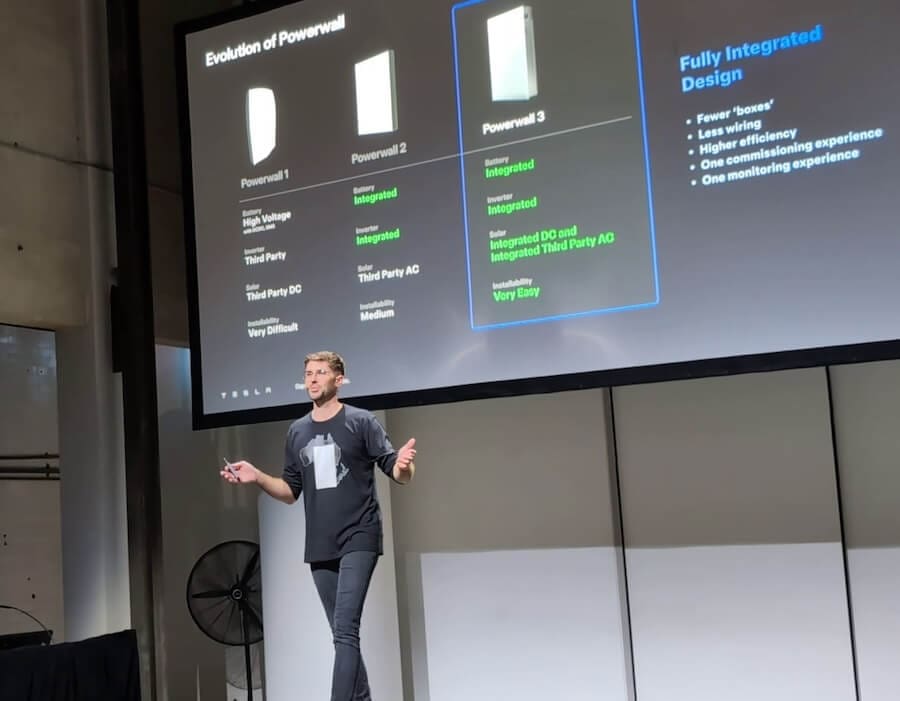
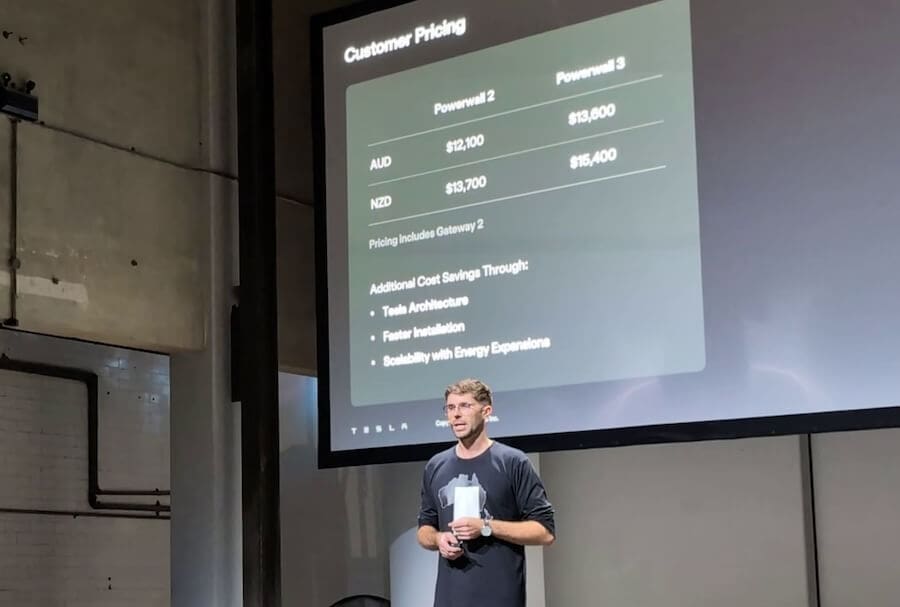

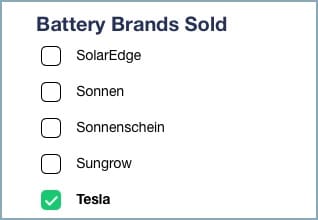
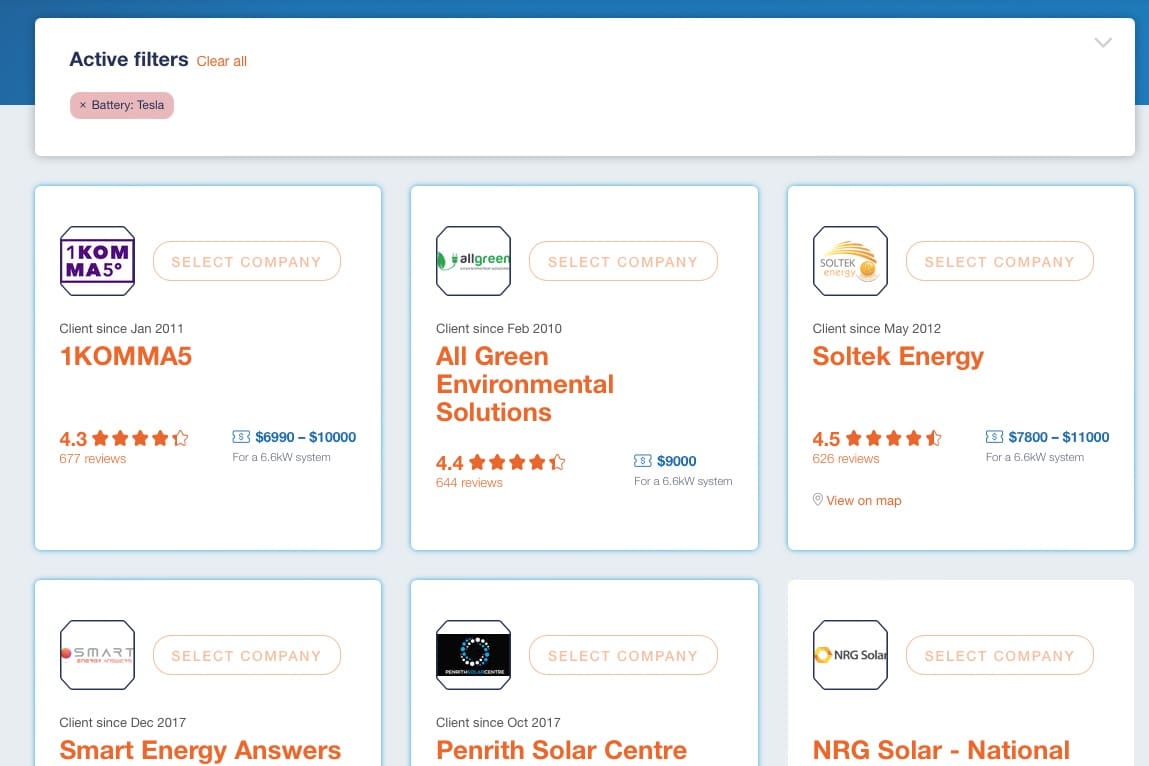
 RSS - Posts
RSS - Posts



A further development in the LiFePO4 vs Li ion battery discussion. Those that support Li ion can now cross off from their list of justifications…. that tesla use Li ion in powerwalls.
All we have to wait for now is the industry malingerers…. you don’t need active cooling with the associated failure risk of thermal runaway, if you use LiFePO4!
How long before all EV car manufacturers decide that the fire risk and atrocious PR from Li ion doesn’t justify the slightly greater energy density benefits… and all turn to LiFePO4 for cars too?
PS… the human verification “please solve” maths question is a bit bizarre… 14 + 9 = 23… but that is not one of the answers in the drop down box!
Hmmm just (15/8/24) signed up for a Power Wall 2 via AGL offer, $11950. However just told could change to Power Wall 3 for more $$ after site inspection.
I have 3 phase and need AC coupling as I have microinverters.
Would it be better for me to stick to the old but tested design? AC coupling for PW3 appears a new add on? Is PW2 batteries much more a fire risk, so insurance goes up??…. too many questions
The presenter at the launch said the PW3 can ac-couple 5kW of solar. That would be inverter capacity.
So if you want to use the PW3, simply ensure you have less than 5kW of Enphase microinverters on the phase that the PW3 is on and it should work.
Thanks Finn for such a quick reply!
3 phase house, with 3 phase air con.
I have 20 microinverters pointed West on one phase, nominal 5kW total (4.864kW as reported by Enlighten app). Also have older DC string (North) on different phase, 3.1kW, ABB inverter. So sometimes have a total of more than 7.3 kW of export.
So I guess either PW2 or PW3 will charge off the AC total export available, up to max of 5kW
If I have a 10kw Enphase system, does this mean the Powerwall 3 can only be charged with half of the system? And this doesn’t change if you get the expansion batteries?
The Tesla guy said at the launch, you could AC couple 5 kW of solar with one PW3. It would make sense that 2xPW3 could AC couple 10 kW.
Is that quote $11950 all inclusive of parts and labour Mark? If so it is a fair bit cheaper $ / kWh than the PW3 so you’d take less time to earn your money back in savings if you stuck with the older PW2.
Thanks for the enquiry!
$11950 AGL deal includes installation, but also a $1500 discount for joining a VPP. Numbers are below:
x1 Tesla Powerwall 2 battery $12,102.99
Standard battery installation $2,332.00
Deductions
SA Price Adjustment $685.00
AGL Discount $299.99
AGL Virtual Power Plant discount $1,500.00
Total quote amount $11,950.00
Repair options.
Will a failure of a storage or inverter component, lead to the PW3 operating in a degraded state, or fully bricked?
Will the fix be unit or component replacement?
Great question Ian,
I’ll pose that to Tesla and see what they say.
Cheers
You’re not at all paying $11,950, its far closer to $15,556.25.
Then less the SA $685 that we taxpayers pay for because nothing is free in this world.
The Govt partially fund the VPP, obtaining access to our battery capacity so it plays its role in the VPP. ( I firmly believe a good thing to assist stabilizing the grid network). But, for example, there will be times a kWh may be worth $2.75 in the tradable spot market, you will receive 30cents, less admin fees. I have not factored in the loses over 10yrs, but its significant!
AGL have added $300 and taken $299.99 off. Thats how Scotty in Marketing gets his bonus.
So, your $15,556.25 exceeds a ‘Local accredited installer’ that would install a PW2 at approx. $1000 less.
Then you need to accept AGL’s price per kW for Peak, Shoulder & Off Peak. Let’s say AGL are 15% over the market on those costs above a smaller retailer with less overheads.
Plus, the daily connection fee or service charge that the larger retailers are 15-30% higher. We see grid connection fees at $1.75 per day when most retailers are at $1.35 per day so you do the math.
So, your $15,556.25 far exceeds a ‘Local accredited installer’ that would install a PW2 at approx. $1000 less.
Dear Glenn, thanks for your feedback. You appear personally invested in the topic. I didn’t proceed with the quote as after inspecting my 3 phase setup, they would have had to modify my internal switchboard too much for backup circuits.
I am still on a dumb meter so Time of Use tariffs are not (yet) something I deal with.
I am currently looking for a Retailer to get me the best deal on my solar exports, and that will trigger a meter change I guess.
If I understand correctly, the built in solar inverter can put out a max of 15KW AC/DC (with 20KW of panels connected)?
If the battery is not fully charged, the inverter charges it at a maximum rate of 5KW DC leaving 10KW AC available for house loads or export to the grid.
If the battery was fully charged, what happens with the inverters 15KW combined AC/DC output? Can the house consume a full 15KW via AC or is it capped at 10KW AC?
The above scenarios assume a lovely sunny day at luchtime with the inverter generating at it’s maximum.
The AC inverter is 11.04 kW max. So if the battery is full, you’ll have 11.04 kW of AC power available, and the DC will be zero.
In QLD, does the capability of the PW3 allow a single phase system to exceed 5KW when the solar is charging the battery, and exceed 5KW when the battery is charging an EV, regardless of any limits on exporting to the grid? Or would the noted 5KW software lock on the inverter prevent this.
The solar battery charging inside the PW3 is solar DC -> battery DC. So a PW3 configured with 5kW of solar inverter will be able to output 5kW AC to the house AND 5kW of DC to the battery at the same time.
Can the PW3 charge a car (Tesla or other) DC->DC off the solar and provide AC to the home? What control options does it have for this (eg float charge the car with full supply of house demand or full car charge and let grid supply any extra house demand)?
No, there is no DC output for car charging.
Will the black start capability work with a 3 phase install?
If you are using the PW3’s solar inverter on one of the phases, and you don’t have a separate 3-phase solar inverter, then yes, you will be able to black start the phase the PW3 is on. Don’t expect 3 PW3s to black start a 3 phase supply though.
Only if the PW3 was able to retain enough backup reserve overnight it seems.
https://www.tesla.com/support/energy/powerwall/mobile-app/backup-reserve
Will it be possible to unlock MPPTs (as in US version https://service.tesla.com/docs/Public/Energy/Powerwall/Powerwall-3-Installation-Quick-Guide-NA-EN/GUID-84363455-C64B-4F67-8166-4945B775587D.html ) if current is not an issue, especially on complex roof?
great question! no idea
Same question for me, I have 6 roof orientations / shade zones so need the 6 mppts, lower current is not an issue.
Hi Sam,
If you can keep the strings the same length, ie the same number of panels… connecting them in parallel to one MPPT, but facing different directions, is quite acceptable.
Fronius have a white paper on it.
“Fronius have a white paper on it”
If it’s the same white paper they released circa 2012 saying that 1-2% loss was to be expected (based on Fronius lab tests) with East-West parallel strings then I can say that a real World test we did in Perth some years ago says it’s more like 10% loss at midday and worse early morning, late afternoon. Individual strings on MPPTs are always better.
Also, on topic, today’s popular panels typically generate over 13A when solar conditions are good. The new Trina 500W panel is 15A. So connecting two strings in parallel might well mean the 26A max current limit of Powerwall 3 is exceeded. No big deal as the inverter will clip off the extra current and reduce output accordingly.
However TP3’s 26A is significantly better than the Fronius hybrid 1ph Primo GEN24 10kW’s 22A limit. Sungrow’s 10kW 1ph hybrid for example doesn’t do parallels, just 4 x MPPTs, one 16A string on each. So I’m with the others here who say to Tesla Australia…give us the 6 x MPPTs on TP3 that the USA has please !!
Hi Andrew,
This is the document.
My experience has been that an east & west array to one MPPT and the other array facing north for the second MPPT is a brilliant setup and I’ve done them like that since 2015.
If you’ve followed PW3 in the US I think you’ll find they offered 6 MPPT because they were aiming at the Tesla Solar Roof, where glass tile arrays are low current and quite different to 500w sunfarm panels. My impression is that we’ve got a very similar device but Tesla have already paralleled two MPPTs under the bonnet so to speak.
Sungrow’s 4 MPPTs need to be balanced with 150 volts, despite the broad range on the spec sheet, they have been known to play games otherwise.
Cheers
I have 2 separate systems-one 3.7kw system on 2 strings using an ABB 5kW inverter and one 5.6Kw system with optimised panels into a SolarEdge 5kW inverter.
Firstly can a PW3 be retrofitted into this configuration?
Secondly will it compromise the panel optimisation and reporting from the SolarEdge system?
I assume the PW# integrated inverter would be redundant in this type of retrofit.
Thanks.
You could AC couple the SolarEdge system, and you may be able to put the other panels into the Powerwall 3 – although it will depend on the age of the panels and whether they are still on the CEC approved list – it’s a bit of a grey area using old panels with new inverters (from a regulation perspective), but worth a chat with your local installer.
Thanks for the update Finn. Are there limitations to the inverter size on single or three phase in WA? Could 10kw or more be utilised on three phase here?
5 kW per phase in WA
Would this mean to have > 5kw inverter capacity would require 3 seperate PW3s on 3 phase in WA? One on each phase or is this summed so 15kw on 3 phase is from the one PW3 with 5kw going to the battery and 10kw the household?
Hopefully WA will be cool with each PW3 with a 5kW AC inverter and a separate 5kW DC for charging the battery – but you never know with Synergy or Horizon.
If you want more than 5kW AC, you’ll almost certainly need to put another unit on another phase.
Is the Powerwall 3 going to be eligible for the NSW home battery rebate in October?
We won’t know for sure until NSW release ‘the list’.
On the surface the requirement: “minimum warranted throughput of 3.65 MWh per kWh of Usable Battery Capacity” would preclude it (the ‘other use’ warranty is less than this) – but I’ll bet my mountain bike, the NSW government and Tesla find a way to get it eligible.
“Powerwall 3 will have a 5kW configurable variant through software at commissioning”.
It will be interesting to see if Western Power in WA make an exception and allow the above for TP3 as usually unless the inverter is actually CEC approved as a 5kW inverter they don’t allow, because they trust no-one to do it (or later undo it), configurable variants at commissioning.
It looks like a good product. 3 x MPPTs, each can take 2 x strings of about 11 panels in parallel although with a bit of minor clipping when solar conditions are great with the normal 440W to 500W panels that max out at 14-15A.
In WA it should be allowed (subject to my top statement) as a 5kW hybrid and battery on both single and three phase, and an extra one or two on the other two phases of a three phase house if people have the money for that.
I think a genuine three phase 10-15kW three phase hybrid inverter and battery from another brand (Sigenergy, Sungrow, iStore etc) would be a technically superior technical choice than this single phase inverter especially as far as backup goes for larger installs.
Shame that Powerwall 2 is going. I don’t see why they couldn’t run them both as they are really completely different products. TP2 is an excellent fit for our rules in WA for single phase AC Coupling in WA and TP3 won’t be.
Hmmm
Would like some more info on the “inverter”.
I’ve got an 8kW Fronius symo 3 phase inverter and 9.24kW in panels.
Already broke even on the setup last year in November so really considering a PW3.
Any guidance on whether or not I should just hook up the PW3 to existing or dump/sell (is there even a second hand market?) the Fronius and use Tesla?
Not sure if it matters but I’m in NSW.
Hi Roland,
Your current setup means you’ve got 2.6kW of inverter capacity per phase. To maintain balance & keep below 10kW per phase you’d need the 5kW nominal PW3 (unless your DNSP allows 12.6kW/phase?)
If you remove the Fronius I’m not sure they’ll let you have more than 5kW of imbalance between phases, so a 10kW PW3 would need a couple of 5kW grid connect solar inverters to get things balanced again.
And the system may struggle with voltage rise on the mains as well if its not balanced.
You might be better off with a Sungrow 15kW 3ph machine or a 10kW Fronius Gen24 (and retain your Fronius 8kW with either of them)
Staying within the Fronius ecosystem would at least keep all your monitoring in one place and offer a well integrated EV charger as well.
Thanks Anthony!
Is your suggestion to add a second inverter or replace my existing one with one of the two you mentioned and then hook up a powerwall 3?
Jumping back to the initial query; presume it would also be an option to just use the PW3 as a battery add on only and not use the inverter function?
I don’t have any energy consumption meters anymore as mine was part of the solar analytics 3G shutoff even though I paid lifetime. Based on what I’ve seen with the powerwall software; it looks like consumption is already measured.
Hi Roland,
Without convincing your DNSP to let you have more than the usual 10kW inverter capacity connected… having 3 phase on your place means PW3 isn’t going to be very helpful for you; unless it’s the Sandgroper spec 5kW unit, or you buy three x PW3 10kW and dice the Fronius.
You’ve given me an idea for an article.
Cheers
I’m in a similar position. 10kw 3ph fronius symo with 13kw panels in Vic, looking to add a single pw3 battery. Are you basically saying it’s not compatible with that setup, and couldn’t be used as the sole inverter to run all the panels either? Cheers
Thanks Anthony!
If my intent wasn’t to expand solar panel size; would a PW3 still be compatible?
I feel like I’m not alone with this query. An article/video would be super helpful.
What I understand is: PW3 operates as single phase meaning not all phases can be “backed up” or run off the electricity in my household.
I only plan to get 1 PW3 due to cost and I am OK with that.
What I don’t 100% understand is the below and apologies if you’ve covered it already in a reply. I am still not clear.
1) Can I just add on a PW3 to my existing setup and is the better option to run existing inverter or use the PW3 inverter function? Are there any features/benefits of either option if they both work? (Remember: current inverter is a 3 phase Fronius Symo)
2) How does single phase battery generally work with a household that has 3 phase? Is it just backed up to whatever connects to that one phase and anything I use on phase 2 and 3 are “charged” like normal electricity use or is there something installs that diverts electricity or somehow calculates and takes capacity from PW3 even if it’s not wired to that phase? Hope this makes sense!
Roland, Why don’t you consider BYD battery? By reading what the new PW3 does, apart of the efficiency is a superior product (in my opinion). BYD integrates very well with Fronius inverters and not to mention seems cheaper than any PW.
In my case I have the non hybrid symo 3 phase inverter. So no byd unless I replace the inverter/ add a new one.
Hi B,
It’s a real frustration that the new Fronius Gen24 doesn’t talk directly to your old Symo, however they do marry up via Solarweb monitoring so if you want to keep everything under one roof and incorporate a smart EV charger, Fronius is still a great option.
They are not LiFePO4, and that’s a part of the PW3 story.
I’ll be honest here… I’ve only seen a flood of Tesla news over the past couple of years and not so much BYD for home batteries. Will definitely need to look into this one.
Are there any clear advantages or benefits on the BYD over the PW3?
I’d just want to join a VPP similar to Amber so that function is a “must have” in my eyes.
The BYD batteries are LiFePO4. Don’t they use the blade battery set up?
Thanks for responding Anthony. If I was to add another fronius inverter (say a 5kw using one more roof face with new panels) could it also power the other Symo non hybrid inverter and use its solar energy for backup/charging the battery during a blackout? I’ve read your 3 phase backup articles and the combinations are a bit confusing to me. Cheers.
With my long Solar saga I came to conclusion that the offerings are for the industry members themselves and the end user is mostly out of the picture. As an end user, why on earth would I want everything built into a single unit? One component fails and the entire thing has to be replaced? What if there is no replacement as it happens with Sungrow which would rather supply new installations instead of replacing already installed faulty units?
Also disturbing to learn that already installed Teslas were not LFP, while these days those were standard for Chinese brands.
just buy some power off the grid when you need it silly billys
How come no one ever drills Tesla on when true 3 phase loads will be backed up by Powerwall?
Everyone has known this already “When is native 3 phase support available?
“PW3 can support loads on multiphase sites through net metering with backup on a single phase”.”
Is Tesla just dodging the question or is the right question not being asked?
Hi Aaron,
Tesla won’t offer proper 3 phase because they’re US designed & and the 110v peasants simply don’t have 3 phase outside of industrial settings.
Their whole domestic grid is based on 220v split phase supply so there’s no market for 3ph. Same reason they came up with their own standard for an EV charging plug, they only need 2 pins, not four like the rest of the civilised world.
PW2 has never supported a 3ph synchronous load, even when you bought 3 of them, so unless Tesla suddenly develop an interest in some place outside “the lower 48” I don’t expect anything will change.
I couldn’t find the PW3 storage capacity in the article, only that 4 PW3s add up to 54kWh (=13.5kWh per unit). Maybe include in the summary at the top?
(I realise that those in the industry already know this from earlier reports but it is handy info for us amateurs).
Cheers
BTW – the Tesla promo page for the PW3 has a picture of a house with the PW3 apparently exposed to the midday sun. I thought this was a no-no?
https://www.tesla.com/en_au/powerwall/
Hi Michael,
Promo images are misleading but at least they didn’t put them inside the living room like some.
In Australia the rules mandate inverters can’t go on the north wall unprotected.
What would be the maximum distance for DC wiring between the solar panels and the inverter?
My current inverter is really close to my panels, and a DC run to a covered area for batteries would be a bit of a distance.
Alternatively I could place them on an outside wall facing NW and build some shading around them – that run would be around 4 – 5m.
Hi Dale,
Have a read here for details on distances.
https://www.solarquotes.com.au/blog/solar-voltage-rise-drop/
https://www.solarquotes.com.au/blog/shed-solar-distance/
If I have existing 13.3kW Solar into a GoodWe 10kW Inverter + Tesla Gateway 2 + Tesla PowerWall 2, is it possible to add additional PowerWall 3 + PowerWall 3 Energy Expansions? Can my existing PowerWall 2 and new addition of PowerWall 3 + PowerWall 3 Energy Expansions just plug into the existing Tesla Gateway 2 or do I need a new Tesla Gateway 3
I looked into PW3 as a PW2 owner, but found that they don’t play together sadly.
Regarding the Expansion Units
Was there any more info on the expansion unit and why they’re no saying it’s not compatible with the PW2. When they did their original video on the release they informed the PW2 and the expansion module was compatible via the GW2.
Why is that now not the case?
I note the PW3’s built in inverter supports 20kW of panels with 3 MPPT’s – do you know what the max string size (in kW of panels) is allowed on an MPPT?
I have an existing system (2 x 5kW Huawei inverters currently using all 4 MPPT’s with 2 strings of 7 panels ~5.5kW facing east and 2 x 10 panels on the west ~7.8kW)
In Sydney on single phase – wondering if it’s possible/allowed to drop in a PW3 (replacing the 2x5kW inverters?) and add some more panels (on the 3rd MPPT)?
e.g. does the PW3 allow 8kW of panels on one MPPT; does Ausgrid allow adding more than 13.3kW of panels if you’re adding a battery (on single phase); or if the Huawei inverters are being kept (e.g. AC coupling) does Ausgrid allow a combined system with technically 20kW of inverters on single phase
Thanks
Hi Rodney,
This might help with connection rules but generally it’s no more than 10kW of inverter per phase.
https://www.solarquotes.com.au/grid-connection/
Huawei have now been taken on, rebranded & locally supported with a local app under the name iStore, so you might look at their products for a battery.
Without knowing your exact panel spec I would guess that a PW3 will offer more capacity by using the third MPPT
https://www.solarquotes.com.au/blog/beat-solar-oversize-rule/
Hope that helps
I would like to install a 20kW solar array connected to a single-phase supply in York Penninsula. Will the PowerWall 3 allow me to get approval from SAPN for the overall installation?
You should be able to install a Powerwall 3 with 20kW of panels, but you may have to limit the export to 5kW until ‘Dynamic Exports’ become available in your area. A local installer can apply for a connection with SAPN to confirm.
Hello Finn. Do you have any updates on the NSW battery subsidy scheme and whether the Tesla PW3 or any Tesla battery is yet a certified system? Can you please clarify when the PW3 will be available in Australia?
Hi Geoffrey,
Ronald is sitting in on a meeting about the NSW battery schemozzle this afternoon so we’ll see what we learn there.
PW3 would be available once it’s CEC approved, which sadly is anyone’s guess, but I’ll ask Tesla.
It would have been nice to ask two rather important questions…
1. Are you going to allow local control of the PowerWall (or free unlimited Tesla API calls) for owners who want to use their battery for energy trading (ie Amber).
2. Inverter export limiting control by owners (ie Amber and negative feed-in).
Yes, we’re early adopters. But that model is going to take off. I hate that Tesla won;t let us control our own batteries without their permanent ongoing permission to do so on every single transaction.
Of course I could control my battery when I bought it. They took that away via a “software update” without telling me until it was applied. For my money, I’d never touch them again, not with a barge pole. When I bought an EV I got a Hyundai Ioniq 5, and had to wait quite a while, but there was no way I was going to give Tesla my money again until they reform themselves.
Great questions that we missed! We’ll try and get answers for you…
Is there any battery solution that does work well with 3 phase wiring?
Hi Gordon,
First 4 articles here cover it in detail…
https://www.solarquotes.com.au/search/?addsearch=3%20phase%20battery
Just trying to understand a bit more about this. I’m in SA, I have a 3 phase house if I put the 20 kw’s of panels on with the “net metering” will I be able to export the full 10-11 kw’s the inverter is producing or would I be limited to the 5kw by SAPN?
Also probably a silly question but if everything in my house is a single phase will this back up everything? Or are circuits/appliances usually placed on different phases so id have to pick and chose? Cheers.
Hi Corey,
You would need a 5kW PW3 to meet the phase balance rules, or a 10kW PW3 and another two 5kW grid connect inverters on the other phases.
SAPN allow full export under flexible connection rules but they might turn the system down occasionally.
Usually you pick a single phase to back up and load the stuff you want on there.
https://www.solarquotes.com.au/search/?addsearch=3%20phase%20battery
https://support.solarquotes.com.au/hc/en-us/search?utf8=%E2%9C%93&query=Three+phase
Hi thinktank,
With the Powerwall 3, the 3 phase and Lipos4 has me seriously thinking about adding this to our house.
Our current setup is 3 phase into the house with 20kw of panels on the roof / 15kw inverter.
Fronius Symo 15.0kw Inverter
70x REC 285w Black TP2 Panels
Does this mean we could replace the Fronius Symo 15kw Inverter and have the Powerwall 3 handle the solar duties ?
Given our air conditioner is 3 phase unit, in the event of a blackout/loss of grid power this powerwall will only be able to support items on a single phase in the house?
So we’d potentially have to have an electrician rewire circuits to ensure critical items like fridges / servers are on that particular phase ?
One thing thats not clear to me, while it says 3 phase support, if we have our 3 phase air con unit on at night, is the air con using power from the powerwall 3 ?
Or is it pulling from the grid.
Given our air con is the most power hungry device during summer nights, if I’m interpreting it correctly the Air Con would still draw from the grid and not the battery?
If that is the case, what benefit / why are people going PW3 with 3 phase setups in Australia? Am I missing something or just not understanding how it works?
Thanks
Hi Mario,
PW 3 doesn’t support 3 phase.
Tesla won’t offer proper 3 phase because they’re US designed & and the 110v peasants simply don’t have 3 phase outside of industrial settings.
Their whole domestic grid is based on 220v split phase supply so there’s no market for 3ph. Same reason they came up with their own standard for an EV charging plug, they only need 2 pins, not four like the rest of the civilised world.
You could get a Fronius Gen24 10kW with BYD battery and keep everything under the same app.
You could AC couple with a few others like GoodWe, Sungrow (or Sigen when they get an approval perhaps)
I am totally baffled as to what makes people like Mario think PW3 is a suitable product for 3 phase. How many times do you have to repeat that it is a single phase inverter? SINGLE PHASE everyone.
I can tell you why those of us who aren’t sparkies come to the coclusion that Powerwalls can be used for three phase – Tesla and their installers are not exactly up front that Powerwalls are not ideal for three phase power. I know this from personal experience.
When we originally looked into the Powerwall for our three phase house, we told them that we were starting with one battery but planned to get three over time. They did not question as to why we wanted three batteries for a three phase house, and the installers did not correct me when we chose which phase the single Powerwall would connect to and I said we can connect another with the next battery.
The Powerwall has worked well and been going strong for 8 years – they even turned up to replace it last year because it recorded a fault that we did not know about. In saying that when we are ready to expand our battery backup system we’ll be going through Solar Quotes as the combination of us feeling misled & Elon being who Elon is, Tesla won’t be getting any more of our money lol.
Don’t know if I missed this in the Q&A, or if my needs are too unique – but, can the PW3 be AC coupled AND DC coupled at the same time?
With a very complex but small roof and a new install, the original designs are all microinverter – but if I have to buy the integrated inverter with the PW3 anyway, could I feed in AC from half the panels on micros, but make use of two strings into two MPPT?
Same but simpler use case, if it’s DC coupled to the panels, can this PW accept grid AC for charging (i.e. during cheap offpeak to redirect to an EV in peak hours)?
Any word on when approvals will be given for install in WA?
You can check the CEC approved list by entering Tesla here…
https://cleanenergycouncil.org.au/industry-programs/products-program/approved-inverters
At the moment only the PW2 is showing as approved.
It might be a week or a month, or not all all, afterwards that Western Power list it. The ‘not at all’ option albeit a bit unlikely is still a possibility if Tesla haven’t applied for a 5kW version with the CEC. Western Power haven’t previously been at all happy trusting installers to set a 5kW limit on a 10kW single phase inverter as required atm in WA.
Other way to know it is approved if is listen out for all the whoops and cheers down the street from the people hanging out to get one of these puppies.
Powerwall 3 was showing as CEC approved this morning for 5kW, 10kW and 11kW models. That means almost certainly that Western Power will allow the 5kW model as it appears to be ‘factory set’ to 5kW.
O.K – please be mindful – complete novice here, after best advice.
Adelaide – S.A
Currently have existing Solar.
5.5 Kw on a SMA 5 Kw inverter.
11.5Kw on 2 off – 5kws inverters.
each inverter is on a single phase.
property is classified as 3 phase.
Looking at installing – 2 off – PW3’s – 27Kw – total storage system.
noob questions:
Can the batteries be placed on two seperate phases to maximise – the 5kw charging feature ?
i.e a battery to each seperate system ?
is it possible to back up – whole house or best to just do the critical circuits.
obviously whole house drains downs faster if not mindful ect…
Thank you
Hi Trevor,
Electrically you can have a PW3 on each phase and have an AC coupled SMA inverter that will run when there’s a power outage, however there are a couple caveats.
SAPN only allow solar inverter capacity of 10kW per phase, but they will allow an extra 10kW of battery inverter per phase up to a site limit of 30kW in total.
Hybrids like PW3 are considered both solar and battery, so they count toward both allowable totals, ie a 10kW PW3 would mean you have to bin the 5kW SMA… unless the PW3 is derated at install time to make it a 5kW unit. (This is a sandgroper spec™ modification to make them available to WA residents)
However as I type, this mental experiment has resolved your issue. What’s electrically possible is a moot point.
Installing PW3 menas you need a new connection agreement with SAPN and because they refuse to grandfather any existing gear, your old inverters have to go in the bin sadly. The SMA units can’t be made compatible with flexible exports rules (or the latest AS4777)
The silver lining is that your old solar is likely to hook straight up to the new inverter, and you’ll be able to add nearly 30kW more if you have the roof space.
This post helps explain :
https://www.solarquotes.com.au/blog/flexible-exports-e-waste/
https://www.solarquotes.com.au/blog/expanding-your-solar-pt1/
So in layman’s terms the 3 existing 5kws – 1off SMA and 2 off Fronious inverters
Get scrapped and the 2 solar array systems get direct coupled to the PW3’S
Is that correct ?
Yes Trevor I think that’s the case.
Perhaps I misread your ticket as only having 2 solar inverters? So bin the SMA, keep one Fronius online perhaps ( and have a spare unit)
In any case two solar inverters are replaced by PW3 units.
Really it comes down to your DNSP rules and wether you can maintain phase balance.
On a 3ph premises in SAPN territory you could have two 10kW PW3 and a 5kW Fronius, (assuming they’ll both work with flexible exports)
16 other networks across the country may have different ideas.
I think I understand now, Thank you.
In my original message: to clarify
one (5.5kw) solar array on a 5kw – SMA inverter.
one (11.5kw) solar array on two 5kw – Fronius inverters.
Total – (17kw) system on three – inverters.
Sounds like it means – scrap the original inverters and run the solar panels directly to the PW3’s – built in inverters.
Hi Trevor,
If your DNSP demands flexible exports, the old SMA goes in the bin yes. Emergency backstop might be done another way, perhaps CatchControl to switch off a legacy inverter but it may cost as much as a new one to implement? Fronius are capable of flexible/backstop but your installer would need to make sure both brands of hardware play nicely.
If you can keep one 5kW inverter then it will be the phase balance you need to offset 10kW PW3 on the other phases.
Without 5kW of generation on the third phase, some authorities will demand the PW3 are commissioned as sandgroper spec PW2.5 units… ie they limit them to 5kW like a PW2.
Hope that makes sense
Hi. We have a PW2 and are considering getting a second unit. I have had an installer trying to get me to do the deal now cos he says PW2 supply is about to stop. Do you know if this is true?
Also, you said PW3 is not yet compatible w PW2. Do you know if or when this will change?
Thanks
John
Hi John,
PW2 will be discontinued soon I’ve heard that direct from Tesla.
There’s been no word on future compatibility between generations of Tesla.
Is it unusual that the PW3 is taking so long to get onto the approved battery subsidy list in Victoria?
Subisdy on battery in Victoria??
Is that a thing?
I didn’t think Vic had any subsidies for batteries.
Sorry, I’m referring to the eligibility list for their interest free solar battery loans program: https://www.solar.vic.gov.au/product-lists#solar-batteries
The reason I got mixed up is that the NT’s HBBS (battery subsidy) uses the Vic eligibility list.
Hi,
One of the restrictions I see with the PW3 if you want to use it for a large single-phase installation is the 5kW charging limit (potentially 8 kW with an expander). If you want 40 kWh or larger storage with 20 kW of panels, for example, it will be hard to charge it quickly enough to be useful. In SE Queensland, where I am, I believe you can’t have more than 10 kW of inverter per phase. Would it be possible to make the charge rate much better by putting in 2 x 5 kW PW3s with whatever extenders added to get to 40+ kW of storage and thus double the charge rate to 10 kW (or greater if the extender allows 8 kW on an inverter). If I read the specs correctly, that should still give a combined supply to the house from solar or batteries of 10 kW (5 kW from each PW3) as well as 6 MPPTs and connection for 40 kW of panels (not that more than 20 would be allowed).
Would there be any drawbacks or issues with the above arrangement, apart from costing slightly more than using one 10 kW PW3.